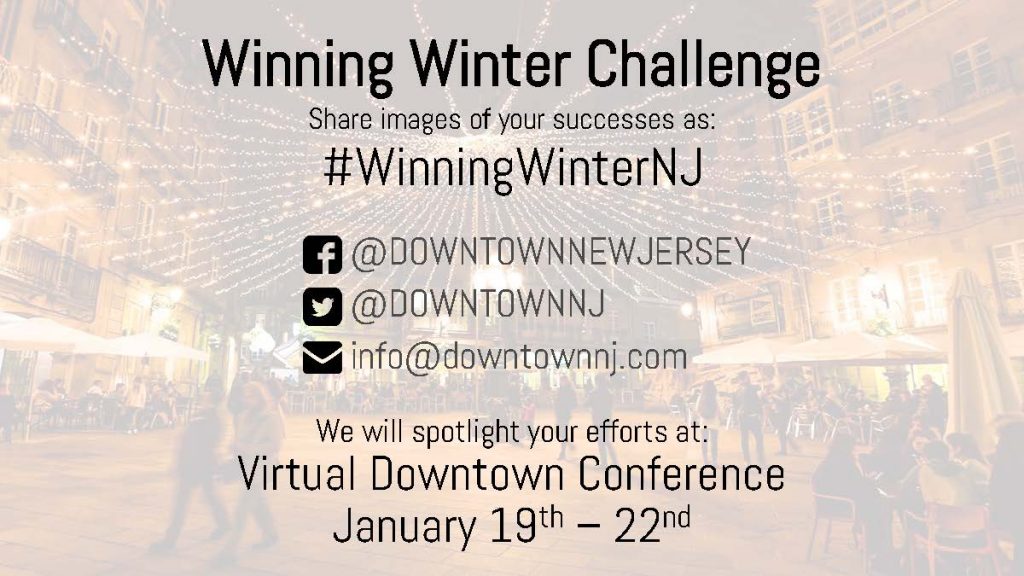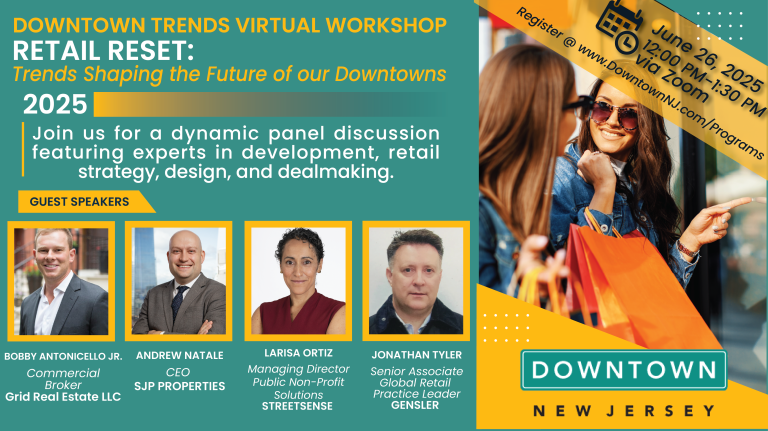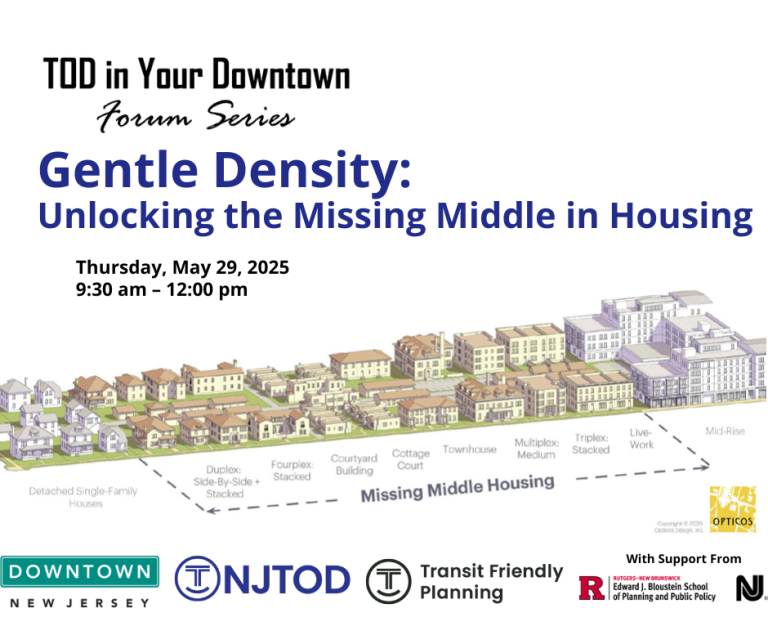Winning Winter
Rebecca Kutner
Assistant Planner, Mercer Planning Associates
October 2, 2020
Downtown New Jersey provided a series of virtual opportunities for downtown managers, economic development professionals, and public officials to exchange ideas about best practices related to downtown economic development in light of the COVID-19 crisis.
Powerpoint>
Creating a Winter City
Jaime Izurieta, from Storefront Mastery, is a self-described “storefront ninja,” is a town planner and urban designer who specializes in storefront design, economic development, and historic preservation. He consults with downtowns on how to boost economic development and placemaking through design.
With colder weather right around the corner, people are searching to the find the best way to prepare their cities and towns for winter. While heaters may seem like the first go to, what downtowns really need to do is to make residents proud and to inspire the community. When you think of cities that exist in places with extreme weather, they used built solutions to create additional interest and that help people to feel more comfortable outside.
Keeping this in mind, Izurieta says there should be four goals in any strategy to “win winter.”
Goal 1: Set the Stage
To set the stage, downtowns should use architectural features that make sidewalks functional for year-round activities. These features may include freestanding roof elements, arcades, or Italian-style loggias. These features help protect people from different types of weather, including rain, snow, and wind, and thus allow for events to be held despite the cold or inclement weather.
One idea to make this possible, is to set up a “hackathon” hosted by the downtown, with local makers, carpenters, and/or builders to find the safest, most efficient, and most cost-effective solution. The prototypes should be tested and continuously tweaked to create a useable product that can be used every season. As these iterations occur, they need to be evaluated to ensure the finished product is what the downtown wants and needs.
Downtowns should also look at business owners and how their individual efforts can help the entire ecosystem of the town. In doing so, municipalities can leverage the placemaking power of these businesses. This enables grassroots efforts to come to fruition. To aid businesses in this endeavor, municipalities should think about how to expedite permits to let business owners make their space, both indoors and outdoors, as inviting as possible. Municipalities should also produce guidelines for businesses to use, so they know they are not stepping over the line. The goal is to leverage individual actions in a controlled environment.
Goal 2: Build Pride
Creating a brand, like “Made in Winter City, NJ”, is a simple, fun way to build pride and unify the community. To do this, the downtown should initiate a collaborative and municipal-wide process for engagement and “pridemaking” through the brand. Businesses can use the stamp “Made In” on locally produced goods or subsidize locally made winter gear.
The brand should also be promoted through events held throughout the season. Some of these events might start a new tradition in the downtown. An example are polar bear dips that organize jumps into a local water body (normally on New Year’s) in support of a local charity. Establishing an annual event, or even multiple annual events, makes creates excitement and brings people to the downtown.
Municipalities and downtown organizations can also offer direct, one-on-one assistance to retailers and food & beverage establishments to adapt their operations to winter conditions. Assistance could include building menus around the cold, building an outdoor structures, a primer on “inside out” operations, adapting to an outdoor winter market context, or staging winter village storefronts.
Goal 3: Boost Identity
To boost a downtown identity, create a “Manufactures of Winter” program. Bring all the local makers, particularly those who can make goods to help people survive the winter outside together. Establish a permanent winter market, and don’t take the market down once the holiday season is over. The outdoor market should offer winter gear, locally made goods, and lots of “warming” food and beverage options, such as cider or even gluweihn, which is a type of mulled wine. There can also be moveable carts with pre-warmed gear or hot beverages. This creates an environment where people want to spend time because it does not feel cold. Given current health concerns, these winter markets should also be spaced in such a way that people can remain distanced.
Another way to boost identity is to use drama and local folklore. The town or downtown organization could research local folklore characters and stories, and then hire actors to portray them. The actors could be right out on the street interacting with residents, telling the stories of winters past.
Downtowns can also use “guerilla warming” by painting “warm” murals, such as a flame or fire, and covering leafless trees with warm lights and even yarn, to change people’s perception of the trees. Wherever possible, create the feeling of warmth through displays in public spaces and in storefronts by using warm light rather than cool light. The effect is more psychological than physical, but it can help keep people from wanting to go home.
Goal 4: Offer a Reward
Make the downtown convenient and fun. Accentuate the value of downtown by adding coffee or cider carts and subsidized blanket, scarf, and glove vending. Towns can also create a firewood depot for residents to get their firewood, winter survival clubs for knitters, and other warm-feeling activities. Downtowns can offer promotions for goods from local retailers and vendors that reward customers for shopping.
Giveaways are another way to reward people for spending their time and money downtown. These giveaways can be blankets, scarves, coffee, or anything else that can entice people to spend time outdoors and their money. There should be a close interaction with those who are coming to downtowns to encourage others to come and build the brand of “Winter City, NJ.”
What to do next?
Now that you have goals and strategies, the next question is what do with them. Of course, downtowns and businesses do need heaters, but we also need to have a discussion about how to use public space when it is colder. People need a reason to leave their homes and spend time outside in the winter months, particularly now when patronizing business inside is still undesirable to many. To start the conversation, survey local makers and manufactures, and conduct an assessment of local regulations that can be waived and/or amended so that businesses can implement ideas with ease. These ideas are not exhaustive, but rather are a starting point for downtowns to begin the conversation and begin implementation.
Winter Activation Strategies
Isaac Kremer, the Executive Director of Metuchen Downtown Alliance, is an expert in the Main Street Approach to commercial revitalization. He has worked with many Main Street and historic preservation organizations in Michigan, Texas, New York, Kentucky, and New Jersey. Mr. Kremer’s presentation included many examples and photos of what downtowns can do to create a welcoming, warming, and winterized downtown. Please be sure to check out the PowerPoint presentation to see all the images he included and discussed.The American experience during the holidays, and over the course of the winter season, is that of crowded winter villages and markets, ice rinks, and lots of lights. But this year, winter will be different. Usually during the winter months, most of our time is spent indoors, whether that is going to restaurants or bars or even shopping. This winter, however, there are risks to spending a prolonged period of time indoors with people you don’t know. The constraints on downtown businesses this year mean that downtown organizations will need to think creatively to ensure that residents and visitors alike are coming to the area to spend their time and money.So, what are downtowns to do?
If the usual way of doing business in the winter, crowded outdoor and indoor shopping, is no longer an option, what can downtown’s do? Kremer says, that downtowns should spread events, displays, and markets out spatially and temporally. Winter markets and other types of displays should be spread out enough that people are able to be distant and comfortable walking around. In addition, events or other happenings should be spread throughout the season. There should be a reexamination of the typically low point of the year, that is January through March, and the kinds of events or happenings that can take place during this period to keep downtowns thriving. Kremer says, that there should be lots of small, good things or events that occur instead of one big event that invites large crowds.It is important for downtowns to remember that proximity of activations to commercial centers is key. One suggestion is to consider a two-block area, or a relatively small area, with at least six activations and/or retail shops within eyeshot, as the proximity businesses and visuals is psychologically appealing to customersIdeas for Downtowns
Downtowns should consider the five senses when considering ideas for their winter city. Consider sight, touch, taste, smell, and hearing and how they can be used to entice people to come to the downtown.By using lights, color, music, food, and heat sources, downtown can make streets and other public spaces truly inviting places to be during the winter. First is sight, lighting, either small twinkle lights, net lights, snowflakes, or even larger light sculptures, can bring interest and comfort to downtown. It might also be a good idea to keep lights up longer this year, perhaps even until spring, as a way to keep away the winter blues. Incorporating touch is harder this year, due to COVID, but a fun display, such as a “mistletoe moment” still brings a level of fun for families and sweethearts. People may still be reluctant to eat inside this winter, so brining the taste and smells of the season outside is key. Kremer has some fun suggestions such as smore making, a hot chocolate vendor, or even a hot potato machine. The winter season would not be complete without some form of music playing in the downtown. Downtowns can hire bands for the weekends, featuring different local groups. In addition, there should be places where shoppers can get warm, such as warming huts or yurts.It may be useful to purchase more tents for businesses to provide more protection from the cold. It is important to ensure tents are fire rated, with a wind load of 100 MPH, and properly weighted. Snow load and snow removal is also important. Each tent could range from $8,000 to $20,000, but they will, with heaters, make people feel more comfortable spending time outside in the winter.If retail is not prevalent in your downtown, pop-up shops could be a way to bring new business and customers to the area. Marketspace vendor events, such as The Winter Village at Red Mill, can still operate this year even with COVID restrictions in place.Do not forget about maintenance. Snow removal, for instance, will be particularly important this year to keep people coming to stores and winter villages in the downtown. If there are tall snow piles on the sidewalks or taking up parking space, people may be deterred from shopping and spending time downtownAn Implementation Process
One way to get input and to quickly transform an area is “blackmail yourself” by picking an implementation date and posting it to social media so you are “forced” to follow through. Then, go through a visioning stage and get feedback from stakeholders, use text and photos so people are able to visualize what it might look like. Be sure to share a map, so people know where to find activities. If you don’t have the funds to carry out the plans yourself, raise the money through crowd funding or other fundraising events.The strategies downtown organizations and downtown businesses use should help create a feeling of happiness, a sense of connection and wonder, and even adventure. The decorations and warming ideas do not need to be fancy or extravagant, but they do need to be effective at bringing people outside and to the downtowns. Place is the promotion. Make it attractive, fun, and welcoming and people will come visit along with their dollars.Discussion and Q&A
What are some strategies for managing crowd size and perception of safety?- Having small activities geographically dispersed, and also spacing out the events throughout the winter season.
- The thinking behind some pop-up retail is small money and quick-in/quick-out, meaning the goods should not be expensive and the turnover for those goods should be fairly quick so they are not taking up a lot of shelf space. It might also be a good idea to look locally to see if any businesses or manufactures can fill those kinds of order quickly and cheaply. For example, in Metuchen, a news store bought their own printing press and now other business that want to create their own merchandise can go to them for production. Downtown organizations need to be in the empowerment game to help businesses figure these problems out.
- It doesn’t mean only activate two blocks, but to provide an activation approximately every two blocks. It’s important to keep places activated throughout the day and throughout the season. The key is to have many small events throughout the day and within eyesight of customers. However, it does not necessarily need to be two-blocks.
- You can get an iceless skating rink, about $6000+. It’s going to be tricky to keep people spaced though, perhaps it could be done by appointment.
- Heat lamps need to be hardwired. And you need a home run that goes direct to your panel. You also need a shutoff and timer switch to make sure you can control each unit.In Metuchen, the Downtown Alliance bought the heaters, but the owners are responsible for the installation and electric. It is about $60-$90 per heater per month. DCA recently announced a $1.6 million grant opportunity for designated Main Street communities that could be used for this purpose.
- There are external power sources, generators, but the difficulty comes with bringing people together around a plan that meets code. Everyone is trying to solve this problem, lean on the experience of how other cities, towns, are doing.
- When we think of winter, there are 20 bad days, but most days are just cold. The worst part is the wind. It might be worth looking into an arcade or even temporary structures that could be built to offer protection from the wind. It would be useful to find a basic prototype that can be installed and then improved upon. The Tactical Urbanist’s Guide to Materials and Design is a good resource. Think of every project/product as a pilot. We must be rapidly iterating.
- An arcade is a second floor that encroaches over the sidewalk. It covers and protects people from the rain, snow, and wind. These spaces can also be heated. COVID has upended how we use public space, so it may be a good idea to build into our local codes ways to make it more pleasant to be outside during winter. Example: Arcades in Bologna, Italy
- See examples from Edmonton: Four Season Patio Design Tips Winter Design Guidelines and Policy
Other comments:
- Rahway is trying to do smaller things, such as an artist selfie stroll, where people can take images of murals throughout the city and then be eligible to win a gift card to a local store. This is going on at the same time as a fall scavenger hunt for logos around the city. As a placemaking activity, Rahway is also providing chalk to encourage people to create mini murals.
- Make the layout of activities part of the art and aesthetics of your downtown/event. This will address the issue of social distancing. For example, instead of straight rows of vendors in a winter market, have fewer vendors spread out in an interesting pattern that makes visitors social distance and explore downtown.
- Canadian cities, including the famous Rideau Canal in Ottawa, and other smaller ones in Gatineau, and as well as other Canadian cities do linear, or trail-based, ice skating paths that could work better for physical distancing, especially if they are done one way. Related Article: Skating Trails Are Canada’s New and Amazing Outdoor Trend
- It’s interesting to look at art and how it can be used as an activation point. The idea is to see how different art organizations can support community and help to increase pedestrian traffic. Bringing people downtowns and invite them to discover different aspects and have a view it from a different perspective. Large scale art is one way to do placemaking in a different way. See examples by Creos, a leading agency for touring interactive installations.
- Involve your institutions, especially if they are located in your downtown, for example the library, fire dept, etc. Local libraries, such as Highland Park’s, are encouraging browsing out front of the building, and are holding small lunchtime concerts.
- Edmonton does fantastic work on winter placemaking.
- With some many schools closed or not doing public performances, their drama departments may have interesting set designs that could be used to add interest downtown.




